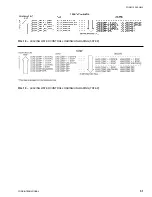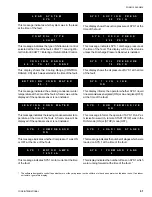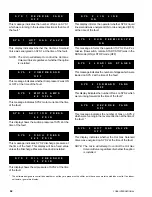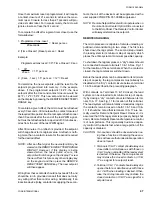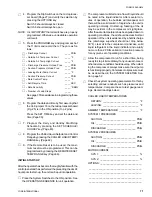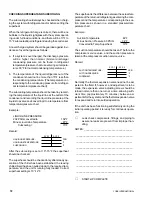
FORM 150.60-NM4
YORK INTERNATIONAL
65
FIG. 24
LEAD/LAG CONTACT CONNECTION
LOCATION
LD02093
26001A
FIG. 25
CLOCK JUMPER
MEMORY BATTERY BACK-UP
The microprocessor board contains a Real Time Clock
(RTC) I.C. Chip with an internal battery back-up. The
battery back-up assures that any programmed values,
clock, all fault information, accumulated information such
as starts/run time, etc. stored in the RTC memory is not
lost when a power failure occurs regardless of the time
period.
The battery is a 10-year lithium type. The life of the
battery with power removed will depend upon whether
the Real Time Clocks internal clock circuit is ener-
gized. With the clock OFF, approximately 10 years
can be expected, with the clock ON, approximately 5
years.
The clock is turned ON and OFF by a jumper on the
microprocessor board. While a chiller is operating, the
clock must be ON. Otherwise the internal clock on the
microprocessor will not be active and the micro cannot
keep track of time, although all other functions will oper-
ate normally. This could result in the chiller not starting
due to the time frozen on the clock falling outside the
START/STOP time window that is programmed in the
DAILY SCHEDULE.
If the chiller is shut down for extended periods of months,
it may be desirable to disable the clock to save battery
life. The clock can then be reactivated and reprogrammed
when the chiller is returned to service.
NOTE: ALL PROGRAMMED VALUES AND STORED
DATA, OTHER THAN THE INTERNAL
CLOCK TlME-KEEPlNG, WILL BE MAIN-
TAINED IN MEMORY REGARDLESS OF
WHETHER THE CLOCK IS ON OR OFF AND
REGARDLESS OF THE LENGTH OF THE
POWER FAILURE.
To disable the clock, place the jumper (Fig. 25) in the
OFF positions. To activate it, place the jumper in the ON
position.
On power-up, the microprocessor will check the Real
Time Clock (RTC Chip) battery to assure that the inter-
nal battery is still operational. This is accomplished by
performing an RTC RAM location check. As long as the
battery checks out, the microprocessor will continue on
with business without interruption.
If a check is made and the battery has failed, the micro-
processor will not allow the chiller to run and the follow-
ing STATUS message will appear:
The only way to run the chiller is to press the MANUAL
OVERRIDE key. Under low battery conditions, the man-
ual override key will function differently than it normally
does in service situations where it overrides the daily
schedule for only 30 min. In a low battery condition, the
MANUAL OVERRIDE key will zero out the daily sched-
ule to allow unlimited operation regardless of the time on
the internal clock. Default values will also be loaded into
memory for all setpoints and cut-outs. These may re-
quire reprogramming to assure they meet chiller operat-
ing requirements. In addition, the low battery message
which is displayed for this condition will disappear.
! !
W A R N I N G
! !
! !
L O W
B A T T E R Y
! !

